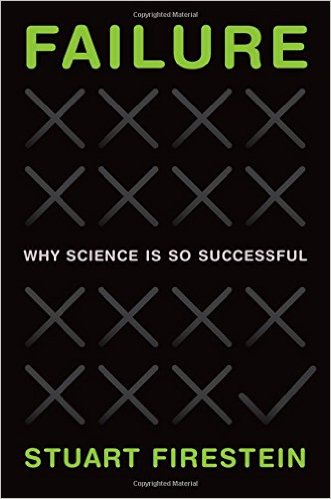Do you see it, readers? The steam pouring out of my ears? Picture this. It’s last Sunday night. I’m doing dishes and listening to some podcasts, scrubbing away not exactly merrily, but efficiently and contentedly, when I heard this: “I happen to believe that we should teach ‛intelligent design’ in classrooms. I think it’s a perfectly reasonable thing to teach.”
Was I listening to a radio evangelist, or a far-right political call-in show? No. I was listening to Science Friday.
 Stuart Firestein, a neuroscientist at Columbia University, was discussing his new book Failure: Why Science is So Successful with Ira Flatow, and it was Firestein who was speaking. As the title of his book suggests, Firestein thinks that science is successful because it’s not afraid to fail. As a corollary, he thinks that it’s important that historical failure should be acknowledged in science education. The “cul-de-sacs” and “wrong turns” of science, he told Flatow, should be presented as well as the triumphs. I agree. We need to teach our kids about science’s brilliant ways of self-correcting and about how null results are important results. Everyone should appreciate that in quests for scientific knowledge, there is often not a “right” answer, but instead a “best answer based on what we know now.” It’s to science’s credit that scientists don’t claim to know absolutely 100% for sure how things work.
Stuart Firestein, a neuroscientist at Columbia University, was discussing his new book Failure: Why Science is So Successful with Ira Flatow, and it was Firestein who was speaking. As the title of his book suggests, Firestein thinks that science is successful because it’s not afraid to fail. As a corollary, he thinks that it’s important that historical failure should be acknowledged in science education. The “cul-de-sacs” and “wrong turns” of science, he told Flatow, should be presented as well as the triumphs. I agree. We need to teach our kids about science’s brilliant ways of self-correcting and about how null results are important results. Everyone should appreciate that in quests for scientific knowledge, there is often not a “right” answer, but instead a “best answer based on what we know now.” It’s to science’s credit that scientists don’t claim to know absolutely 100% for sure how things work.
This is valuable even within the context of evolution (a 10 out of 10 on my made-up SCUR-scale of justified scientific confidence). Students should learn about the theory of use and disuse, for example, in part because it was historically important and in part because it is still intuitively appealing. Plus, Lamarck wasn’t completely wrong about everything—environment and structures are linked, just not via the mechanism he endorsed.
 On Science Friday, Firestein gave an example closer to his intellectual home. He said, of phrenology, that it “was a completely bankrupt idea, but for fifty years it operated as a science, and it still has foundational ideas that are important in modern-day neuroscience.” Phrenology, in case you didn’t know, is the early-nineteenth-century pseudoscience that studied how skull shape supposedly relates to personality. Phrenologists thought that various mental faculties were localized in specific parts of the brain, as revealed by the contours by the skull. Lo and behold: today’s neuroscientists think that various mental faculties are localized in specific parts of the brain—though not the same faculties and the same parts as the phrenologists thought, and not as revealed by the contours of the skull.
On Science Friday, Firestein gave an example closer to his intellectual home. He said, of phrenology, that it “was a completely bankrupt idea, but for fifty years it operated as a science, and it still has foundational ideas that are important in modern-day neuroscience.” Phrenology, in case you didn’t know, is the early-nineteenth-century pseudoscience that studied how skull shape supposedly relates to personality. Phrenologists thought that various mental faculties were localized in specific parts of the brain, as revealed by the contours by the skull. Lo and behold: today’s neuroscientists think that various mental faculties are localized in specific parts of the brain—though not the same faculties and the same parts as the phrenologists thought, and not as revealed by the contours of the skull.
So presumably in teaching neuroscience, Firestein would talk about phrenology in the same way I might talk about Lamarckian ideas about evolution—what it said and why, what it got right and what it got wrong, and whatever continuing relevance it has.
It’s at this point that “intelligent design” entered the conversation. Flatow asked: “Could we teach ’intelligent design’ as a failure?” Now, it’s important to note that Flatow didn’t specify what he meant by “intelligent design.” Of course there’s “intelligent design” in the sense of the specific branding strategy for creationism that was developed in the mid-1980s, popularized in the 1990s, and ruled to be unconstitutional in the public schools ten years ago in Kitzmiller v. Dover. For brevity, let’s call this IDC. But since the context of the discussion was the importance of including history of science in science education, Flatow must have been referring to something else—perhaps he’s using “intelligent design” as a catch-all phrase for any way of thinking that invokes a God (or whatever supernatural entity or entities) as designer of the natural world. Let’s call this generic version of “intelligent design” IDG, for generic.
What’s the relationship between the two? IDC is a version of IDG, but not the only version. “Creation science,” for example, is a version of ICG developed in the 1960s, popularized in the 1970s by the Institute for Creation Research, and ruled to be unconstitutional in the public schools in 1987 in Edwards v. Aguillard. But there are also versions of IDG that don’t aspire to be scientific at all. A theistic evolutionist who says that God is responsible for creating and sustaining the natural world is expressing a version of IDG—but such a version need not have any distinctive testable consequences, and thus could not be scientifically confirmed or disconfirmed, whatever else its merits or demerits may be.
I am dubious that anyone, especially a science journalist like Flatow, would ever use the phrase “intelligent design” to mean anything but the 1980s version. However, given the context, it's possible to give Flatow the benefit of the doubt. It’s also possible that Flatow did mean IDC, but was posing the question so that Firestein could differentiate the kinds of failures that are worthy of study and those that aren’t. Regardless, though, there is no reason to think that Firestein must have understood either Flatow’s usage of the term or his intention in asking the question. So let’s return to his response.
Firestein, again, said, “Yes, I think, I happen to believe that we should teach ‛intelligent design’ in classrooms. I think it’s a perfectly reasonable thing to teach.” This doesn’t help to understand what he was talking about, IDG or IDC, so let’s continue. He added, “Let’s remember that Newton, Faraday, many great scientists clearly would have believed in ‛intelligent design.’”
This puzzling reply is going to take a serious wordcount to unravel. Join me in part 2, won’t you?
Are you a teacher and want to tell us about an amazing free resource? Have an idea for a Misconception Monday or other post? Have a fossil to share? See some good or bad examples of science communication lately? Email or tweet @keeps3.

